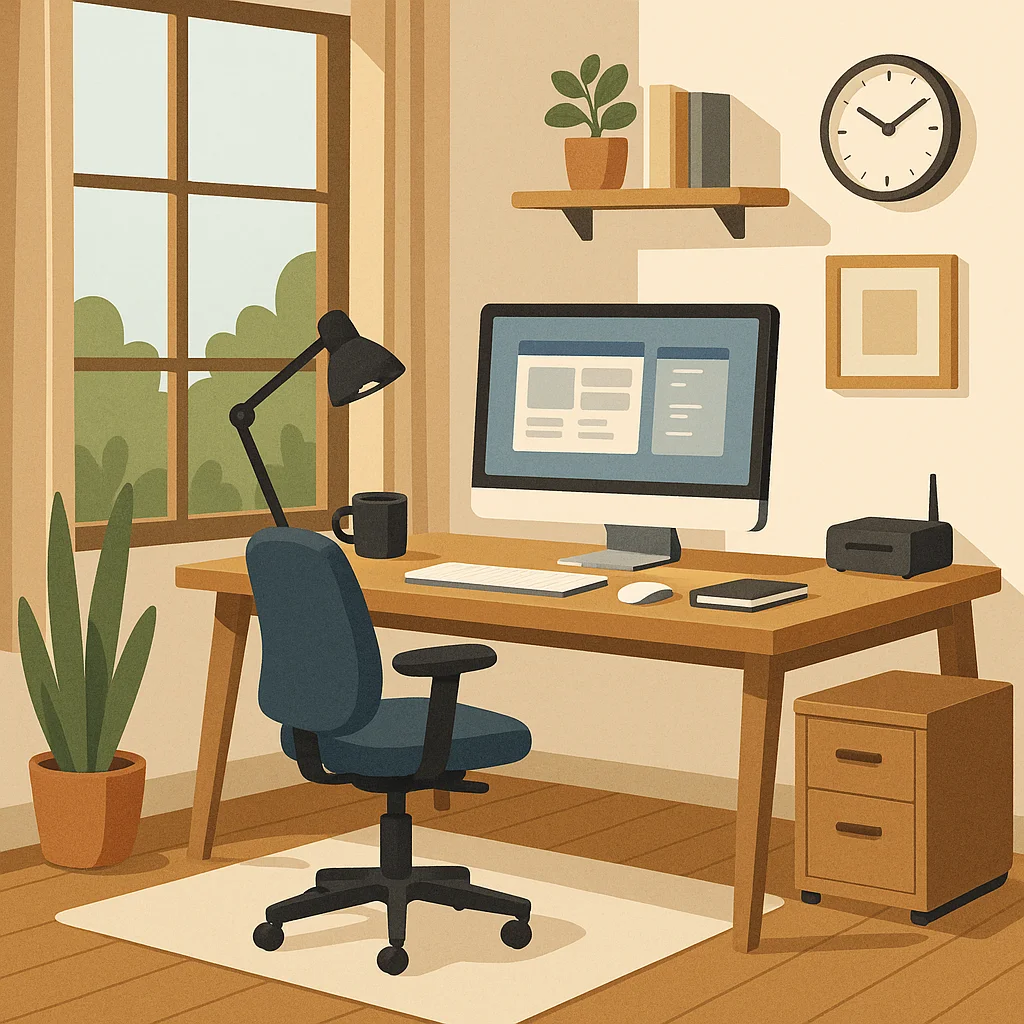Now Reading: How to Set Up a Productive Home Office That Boosts Your Performance
-
01
How to Set Up a Productive Home Office That Boosts Your Performance
How to Set Up a Productive Home Office That Boosts Your Performance

Working from home has become the new normal for many of us, but creating a space that truly supports productivity can be challenging. I’ve discovered that to set up a productive home office requires more than just a laptop and a chair. It demands thoughtful planning, the right equipment, and strategic organization. In this guide, I’ll share everything you need to transform any corner of your home into a productivity powerhouse.
Key Takeaways
To set up a productive home office for remote work:
- Choose a dedicated space with minimal distractions and good natural light
- Invest in ergonomic furniture, especially a quality chair and adjustable desk
- Ensure proper lighting with a combination of natural and artificial sources
- Organize your workspace to minimize clutter and maximize efficiency
- Create clear boundaries between work and personal life
- Incorporate technology that enhances rather than hinders your workflow
- Personalize your space to boost motivation and comfort
Choose The Right Location
The foundation of a productive home office begins with location. I’ve found that selecting the right spot in your home can dramatically impact your focus and efficiency. Ideally, choose a dedicated room with a door you can close to create a clear boundary between work and personal life. This physical separation helps you mentally transition between professional and leisure time.
If a separate room isn’t possible, look for a quiet corner that you can designate solely for work. The key is finding a space with minimal distractions and traffic. Position your workspace away from high-activity areas like the kitchen or living room to reduce interruptions.
Natural light should be a priority when selecting your location. Position your desk near a window to benefit from daylight, which significantly improves mood and productivity. Studies show that natural light boosts vitamin D levels and helps regulate your circadian rhythm, leading to better sleep and daytime energy.
Consider the background for video calls as well. A neutral, professional backdrop will help you maintain a polished appearance during virtual meetings. If noise is an issue in your chosen location, invest in soundproofing solutions like acoustic panels or a white noise machine to create a more professional environment.
Even in smaller living spaces, you can carve out an efficient home office with a bit of creativity. The most important factor is that your workspace feels separate from where you relax, helping your brain associate the area with productivity.
Useful Articles:
Invest In Ergonomic Furniture
After selecting the perfect location, I prioritize ergonomic furniture for my home office. This investment pays dividends in both comfort and long-term health. The cornerstone of any productive workspace is a quality chair that supports proper posture during long work sessions.
Ergonomic Chair
Look for a chair with adjustable height, lumbar support, and armrests. Your feet should rest flat on the floor with your knees at a 90-degree angle when seated. The chair should support the natural curve of your spine to prevent back pain. I recommend testing several options before purchasing, as personal comfort varies widely.
Desk Selection
Your desk is equally important. Consider these factors when choosing:
- Size: Ensure ample surface area for your equipment and tasks
- Height: Ideally adjustable to allow for both sitting and standing
- Ergonomics: Position at a height where your elbows rest at 90-110 degrees while typing
Standing desks or convertible sit-stand options offer flexibility and health benefits by encouraging movement throughout the day. Research shows that alternating between sitting and standing can reduce the risks associated with prolonged sitting, including back pain and cardiovascular issues.
Keyboard and Mouse
Don’t overlook these essential tools. An ergonomic keyboard positions your wrists naturally to prevent strain, while a vertical mouse reduces pressure on your wrist. Position these tools so your arms remain close to your body and your wrists stay neutral-not bent up, down, or to the sides.
The right ergonomic setup might seem expensive initially, but I’ve found it’s one of the wisest investments for remote workers. The cost of quality furniture pales in comparison to the potential medical expenses and productivity loss from repetitive strain injuries or chronic pain.
Optimize Your Lighting Setup
Proper lighting in your home office does more than help you see-it affects your energy levels, mood, and eye health. I’ve discovered that a strategic lighting plan combines natural and artificial sources for optimal results.
Natural light should be your primary source whenever possible. Position your desk perpendicular to windows rather than directly facing them or having your back to them. This arrangement minimizes glare while maximizing the benefits of daylight. If privacy is a concern, consider light-filtering window treatments that diffuse sunlight without blocking it completely.
For artificial lighting, implement a layered approach:
- Ambient lighting: Provides overall illumination for the room
- Task lighting: Focuses light on specific work areas
- Accent lighting: Adds dimension and reduces eye strain from contrast
A quality desk lamp with adjustable brightness and color temperature allows you to customize lighting based on the task at hand. Cooler, bluer light enhances focus during analytical tasks, while warmer light creates a more relaxed atmosphere for creative work.
Be mindful of screen glare, which can cause eye fatigue and headaches. Position monitors away from direct light sources and consider an anti-glare screen if necessary. The brightness of your screen should roughly match the brightness of your surroundings to reduce strain.
Smart lighting systems that adjust throughout the day to mimic natural light patterns can help maintain your circadian rhythm and energy levels. These systems might seem like a luxury, but I’ve found they significantly improve my comfort and productivity during long workdays.
Useful Articles:
Create An Organized Workspace
A cluttered desk leads to a cluttered mind. I’ve learned that organizing my home office is crucial for maintaining focus and efficiency. Start by assessing your workflow and identifying the items you use daily, weekly, and occasionally.
Effective Storage Solutions
Implement a storage system that keeps frequently used items within arm’s reach and less essential supplies tucked away. Consider:
- Desk organizers: For pens, notepads, and small office supplies
- Shelving: Vertical storage that maximizes space
- Filing systems: For important documents (physical or digital)
- Cable management: To prevent tangled wires and visual clutter
I recommend the “touch it once” principle-when you receive a document or item, immediately decide whether to act on it, file it, or discard it rather than creating piles for later.
Digital Organization
Your digital workspace deserves the same attention as your physical one. Establish a logical folder structure for your files and implement a consistent naming convention. Cloud storage solutions like Google Drive or Dropbox allow you to access your work from any device while keeping your computer’s hard drive uncluttered.
Consider using digital productivity tools to streamline your workflow:
- Task management: Trello, Asana, or Notion for tracking projects
- Communication: Slack or Microsoft Teams for team collaboration
- Time tracking: Tools like Toggl or RescueTime to monitor productivity
Regularly schedule time for maintenance of both your physical and digital workspaces. I set aside 15 minutes at the end of each week to reset my office-filing papers, clearing my desk, and organizing digital files. This simple habit ensures I start each week with a clean slate and clear mind.
Establish Tech Infrastructure
A productive home office requires reliable technology that supports rather than hinders your work. I start with a strong internet connection-the lifeline of remote work. If possible, connect your computer directly to your router via Ethernet for the most stable connection. For Wi-Fi users, position your router centrally and consider mesh networks or extenders to eliminate dead zones.
Computer Setup
Your computer should meet the demands of your specific work requirements. Consider these factors:
- Processing power: Sufficient for your typical applications
- Memory (RAM): Enough to handle multitasking
- Storage: SSD drives offer faster performance than traditional hard drives
- Monitor setup: Dual monitors can increase productivity by up to 42%
Position your monitor(s) at eye level, about an arm’s length away. The top of the screen should be at or slightly below eye level to maintain proper neck posture. For laptop users, consider a laptop stand paired with an external keyboard and mouse to achieve ergonomic positioning.
Peripherals And Accessories
Invest in quality peripherals that enhance your workflow:
- Webcam and microphone: Essential for professional video conferencing
- Printer/scanner: If you frequently work with physical documents
- Headphones: Noise-canceling options help minimize distractions
- UPS (Uninterruptible Power Supply): Protects your equipment and work during power outages
Don’t overlook cybersecurity in your home office. Implement strong passwords, enable two-factor authentication, and consider a VPN for secure connections. Regular backups of your work are essential-I use both cloud storage and an external hard drive for redundancy.
Finally, create a tech maintenance schedule. Update software regularly, clean your equipment, and periodically assess whether your technology still meets your needs. Technology should empower your work, not complicate it.
Useful Articles:
Minimize Distractions
Creating a distraction-free environment is perhaps the most challenging aspect of setting up a productive home office. I’ve developed several strategies to maintain focus throughout the workday.
First, communicate boundaries clearly with household members. Establish “do not disturb” signals like a closed door or a specific sign that indicates you’re in deep work mode. For those with children, create a visual schedule so they understand when you’re available and when you need uninterrupted time.
Digital distractions can be even more pervasive than physical ones. I recommend:
- Notification management: Disable non-essential alerts during focused work periods
- Website blockers: Apps like Freedom or Cold Turkey to limit access to distracting websites
- Phone discipline: Keep your phone in another room or use “Do Not Disturb” mode
- Email batching: Check emails at scheduled times rather than continuously
Background noise can either help or hinder productivity, depending on your personal preferences. Some people work best in complete silence, while others benefit from ambient sound. Experiment with:
- White noise machines: Create consistent background sound
- Noise-canceling headphones: Block out environmental distractions
- Focus music: Instrumental tracks designed to enhance concentration
- Nature sounds: Can provide calming background audio
I’ve found that implementing a “transition ritual” helps signal to my brain that it’s time to focus. This might be making a cup of coffee, reviewing my to-do list, or a brief meditation before starting work. This consistent routine helps train your mind to shift into work mode more efficiently.
Personalize Your Space
While functionality should be your primary concern, personalizing your home office creates an environment where you actually want to spend time. I’ve found that thoughtful personalization boosts my mood and motivation throughout the workday.
Add elements that inspire creativity and positive emotions:
- Plants: Live greenery improves air quality and has been shown to reduce stress
- Artwork: Choose pieces that energize rather than distract
- Color psychology: Incorporate colors that promote the mood you want to cultivate (blue for calm focus, yellow for creativity, green for balance)
- Personal mementos: Photos or meaningful objects that remind you of your purpose
The temperature and air quality of your workspace significantly impact comfort and cognitive function. Aim for a temperature between 68-72°F (20-22°C) and ensure proper ventilation. Consider an air purifier if you live in an area with poor air quality or have allergies.
Scent can also influence your work environment. Essential oils like rosemary, peppermint, and lemon have been shown to enhance alertness and concentration. A small diffuser can add this subtle productivity boost to your space.
Remember that personalization should enhance, not detract from, your productivity. Strike a balance between a space that feels welcoming and one that maintains a professional atmosphere, especially if you frequently participate in video calls.
Establish Work Routines
Even the most perfectly designed home office won’t guarantee productivity without structured routines. I’ve found that establishing consistent habits helps maintain focus and work-life balance when working remotely.
Start by defining clear working hours. While remote work offers flexibility, having regular start and end times helps your brain transition between work and personal modes. Communicate these hours to colleagues and family members to set expectations about your availability.
Implement time management techniques that work for your personal style:
- Pomodoro Technique: Work in focused 25-minute intervals with short breaks
- Time blocking: Schedule specific tasks for designated time periods
- 2-minute rule: Immediately complete any task that takes less than two minutes
- Most important tasks (MIT): Identify and tackle your three most critical tasks first
Regular breaks are essential for sustained productivity. I schedule short breaks every 60-90 minutes to rest my eyes, stretch, and reset my focus. These intentional pauses actually improve overall productivity by preventing burnout and decision fatigue.
Create end-of-day and start-of-day rituals that bookend your workday. An evening routine might include reviewing completed tasks, preparing your to-do list for tomorrow, and tidying your workspace. A morning routine could involve reviewing priorities, checking your calendar, and setting intentions for the day.
Finally, build movement into your routine. Remote work often means less natural movement than office-based positions. Schedule regular standing breaks, stretch sessions, or short walks to maintain physical health and mental clarity.
Setting up a productive home office is an investment in both your professional success and personal wellbeing. By thoughtfully selecting your location, investing in ergonomic furniture, optimizing lighting, maintaining organization, establishing solid tech infrastructure, minimizing distractions, personalizing your space, and creating consistent routines, you’ll create an environment that supports your best work.
Useful Articles:





















